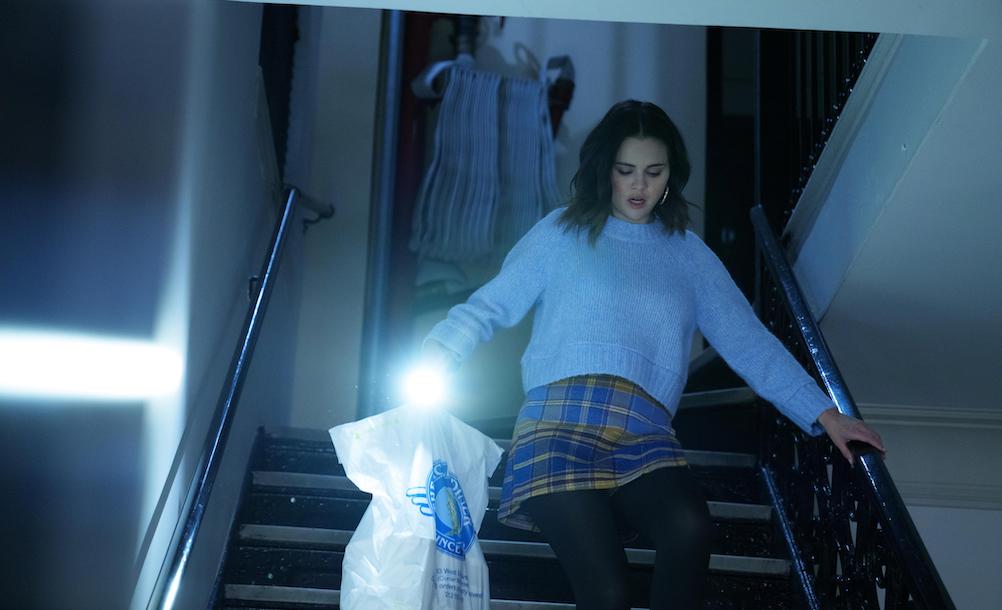
When we last left the Arconia building in Only Murders In The Building (Hulu), the sleuthing podcasting trio Charles Haden-Savage (Steve Martin), Oliver Putnam (Martin Short), and Mabel Mora (Selena Gomez) solved the murder mystery of who killed neighbor Bunny Folger (Jayne Houdyshell), done in by the “#14 Sandwich.” The action in season two, which takes place in their apartments, in Coney Island, through the killer’s secret lair, and in the grand finale for the premiere of Oliver’s comeback play, was shot by cinematographer Chris Teague.
Teague, nominated for an Emmy for “Outstanding Cinematography For A Series (Half-Hour)” for his work on episode ten, “I Know Who Did It,” along with the series 11 total nominations, was the man behind the camera for all 16 episodes going back to the beginning of the series, which premiered on August 31, 2021.
Teague is no stranger to the Emmys, having won in 2019 for Russian Doll. His other credits include episodes for Mrs. America, season three of Glow, season 4 of Broad City, the and Obvious Child, to name a few. Born in upstate New York, Teague gravitated toward photography, which led to an interest in filmmaking and studying at Columbia University School of The Arts, where he became the go-to cinematographer for his classmates student films.
Below The Line spoke with Chris Teague via Zoom video while he was home in the “kid-friendly” neighborhood of Park Slope, Brooklyn. Chris talked about his vision for the series, which began with conversations with creator and showrunner John Hoffman, maintaining a lush noir feel with warm and cool tones throughout the two seasons. Coming full circle on Only Murders In The Building, Chris discussed the opportunity to direct the episode “Hello Darkness,” where cinematographer Dagmar Weaver-Madsen stepped in, working with the comedic cast, not to mention the pinch-me moment of lighting legendary movie star Shirley Maclaine.
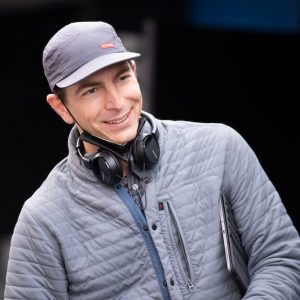
Below The Line: To start with the beginning, what are some of your memories from working on season one?
Chris Teague: It was sort of early pandemic, and it felt like the world had stopped, sort of like it does right now. I got a call out of the blue from (director) Jamie Babbit, who was preparing the show. It was August of 2020, and she introduced me to a few of the episodes of the first season, and she introduced me to (creator) John Hoffman, the showrunner, and Jess Rosenthal, the executive producer. We had one of those really fun meetings where you just really click. The ideas are kind of flowing and everything makes sense, which is a really nice feeling to have the first time you’re meeting somebody, given the script and knowing the cast and everything.
It was just such an easy project to jump onto and just such phenomenal timing to get to work on something that was just meant to make people feel good and give people a reason to come and sit down in the evening and not think about all the other crazy things that were going on in the world. So, yeah, it was great.
BTL: What was your initial pitch in terms of the look of this series, and did it change much in season two?
Teague: We really wanted to maintain a consistent feel in season two. I have to credit John Hoffman for giving us the opportunity to push the contemporary noir look of the show in new directions by giving us some great new circumstances and set pieces to work with, one of which was the secret passageway (the killer’s secret lair) and sets that occur throughout the season. I also shot a whole blackout episode, which is one of the episodes that I got to direct, which was such a fun experience. We definitely were in a lot of the same sets and locations, and we liked the look we had established, but we had the opportunity to apply it to new worlds and new spaces.
BTL: Let’s go through some of those sets, Chris, and the color palettes and why you chose them.
Teague: For each of our main three characters, those sets were kind of very representative of who they are. Steve’s (Charles Haden-Savage’s) sets have color, but they’re also composed. It has warm tones and cool tones. It has variety, whereas Selena’s (Mabel’s) set is a bit more unfinished. It’s messy, but in a way, there are a lot of big open spaces to it, and the light kind of reaches farther into the rooms, and it’s just bolder. The light’s a bit bolder in her space, whereas in Marty’s (Oliver’s) space it is chaotic; it’s just cluttered and a bit heavier and darker in a way. The tones are darker, so that means the light doesn’t quite reach into the room as far. The light likes to kind of bounce off the floor and skip around the room off all these different surfaces that are in the space. Those are some of the ways we thought about it. These are all constructed spaces, but the light works the same way, whether you’re in the real world or on a set. It comes through windows. It bounces off walls, and it has character that’s impacted by the colors and tones and the reflectivity of all these surfaces.
BTL: Who did you have conversations with when designing these looks?
Teague: So these are the conversations we have with Curt (Beech), our production designer in season one, and Patrick (Howe) in season two about how all these choices that they’re making in the art world are going to have an impact on the quality of light in those spaces. One of the big challenges was a decision we made early on that we’re all very much on board for, which was to put real ceilings in all of our sets. I’ve shot other shows where we leave the ceilings open, so we have an opportunity to kind of shoot light from wherever we want and on the grid from above, but you often feel like there’s just something missing.
The space doesn’t feel quite real because those walls just kind of go off into the void. I knew that putting real ceilings on all of our sets would limit my ability to light from whatever direction I might want or present certain challenges, but what that meant was that I just had to work more closely with the production design and set deck departments to find the perfect practicals that would work in these scenes that could not only work as great pops of light or color in the background but could really bring light into the scene when we needed it to because we knew we’d be relying more on the practical lighting in the scenes.
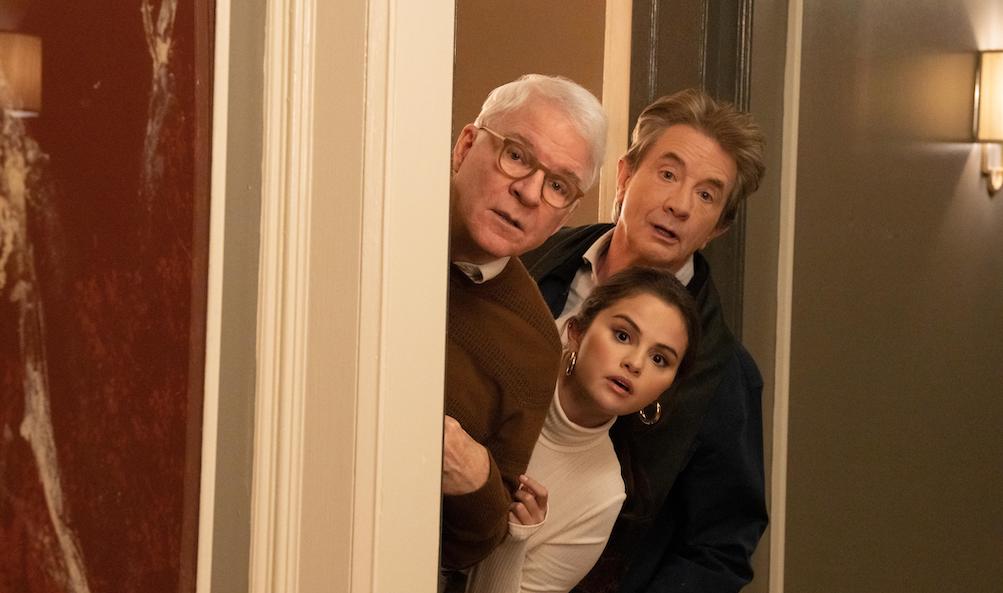
BTL: I kind of felt like some of the tones were orangey at times and then some of them were more blue. Am I on the right page?
Teague: Yeah, absolutely. I think a fun way to talk about warm and cool tones like that is in the new set in season two, the secret passageway set, where we have this very narrow, very challenging space to work in, and we designed it that way. We wanted it to feel claustrophobic and confining and avoid doing the thing that you certainly could do, which is pull away the walls and be able to see from any position. We wanted the camera’s perspective like it was stuck in those hallways, and to do that, we lit it and made it feel like it was different times of day. We’d have to be very careful and sneaky about the way we hid our lights, you know? We would have some kind of soft, cool blue tone coming in from above that seemed more ambient and not really coming from any specific direction. That would signify more of a night look, and we would pair that with kind of harder, sharper warm light coming through the walls as if it’s reaching through the cracks in the walls to give us a little bit of color contrast in that space and a little bit more life.
We did a lot of testing with that about the thickness of the walls, and if we could push light through the walls or if we needed to actually make little openings, which a lot of times we ended up doing. The walls were kind of plaster, and we would poke holes where we wanted to create more patterns on the wall and push warm light through to create the effect as if there was a lamp on the other side of the wall that was just kind of sneaking into our little secret passageway.
BTL: How did you get the cameras through there?
Teague: It was not easy. We had to be very careful about how we planned things. We designed the space to be, in most instances, about three feet wide or slightly less than three feet wide, which was sort of the minimum width that we could possibly fit a steady cam through. If we needed to do steady cam work in there, we could do that. But it was still very challenging for Kyle Wullschleger (who went on to become cinematographer for season three) and our A camera operator. Then, other times it was about blocking and using corners in the hallways to kind of be able to place the camera or move an actor from one space to the next, or get them to land in a place where you could actually turn around and face each other and have a conversation.
There were a few different corners and intersections that we used and reused over and over again and dressed differently to make them feel like different spaces. Occasionally, we would pull out a section of the wall so that we could just poke the nose of the camera through and then still allow actors to pass by and walk through the hallway. We always try to do that with the idea of not letting the camera be so far outside of the wall of the actual set that it would feel like we’re in a set, basically.
BTL: You mentioned the blackout episode (“Hello Darkness”) which was so New York. How was your experience directing that episode?
Teague: Dagmar Weaver-Madsen was the DP for the blackout episode. We had a lot of fun conversations and looked at a lot of references for the real New York City blackouts, what those spaces looked like and felt like, and how those spaces would’ve been lit, whether it was by candlelight, car headlights, or emergency lighting. And trying to be as clever and creative as we could to create different looks that gave you the effect of all the lights being off but still allowed you to see what you needed to see. So, that was fun because we got to spend a lot of time in our sets that we spend the whole season in, but we kind of transformed them with the lighting and created the impression that there’s some emergency lighting way down below in the courtyard space that’s seeping up into the rooms and projecting enough light into the space that you could barely see, or use cell phones (lights) or flashlights to define spaces or motivate other kinds of lighting.
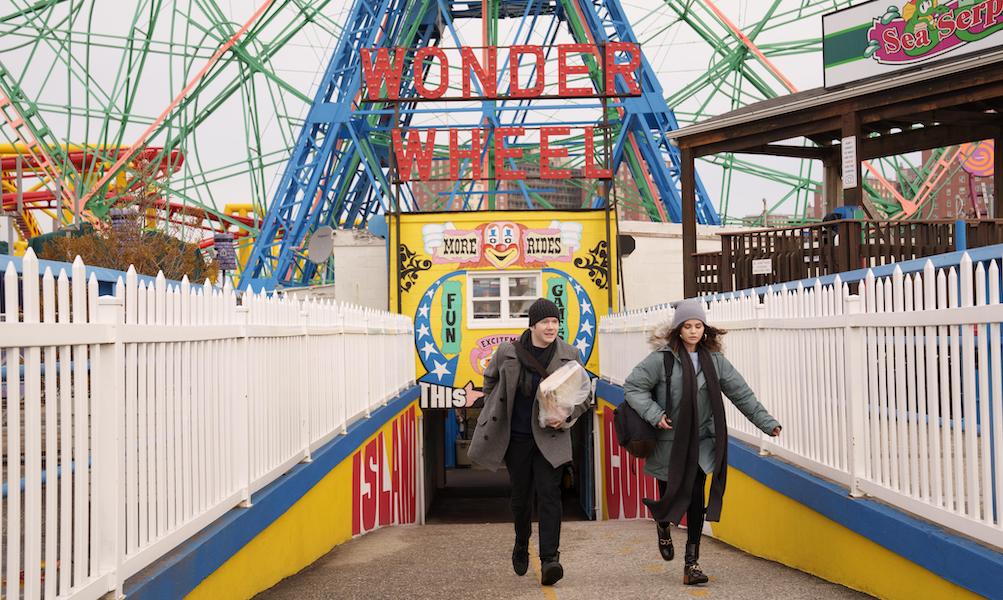
BTL: In terms of locations, talk about shooting in Coney Island. What feeling do you want to capture with that location?
Teague: Coney Island is one of those fun challenges where there are almost too many options—too many great options. You look in every direction, and there’s something exciting that you want to try to capture and bring into the episode, but you only have so much time to spend there, so you have to be really careful about what you’re looking at and try to make the most of it, gather as much as you can, and stage the scenes with great backgrounds. You know, take advantage of the Wonder Wheel, the boardwalk, and all these iconic spaces so that you immediately ground your audience in this really cool space. How fun to be able to shoot it off-season when nobody’s there, which just gives it this great, perfect noir Only Murders touch. It was about squeezing everything we possibly could of Coney Island into that one day.
BTL: You had the legendary Shirley Maclaine as the character of Leonora Folger—the mother of murdered board president, Bunny. Was that a pinch-me moment for you?
Teague: Oh my gosh. It’s really incredible. I’ve had a few moments where I feel like I’ve been in the presence of someone who represents the history of cinema in this incredible way, who’s a legend, and I think you have to put that stuff aside and do your job and not let it get to you, because it certainly could get to you! You recognize that we’re all there to accomplish the same thing. She’s there to act and do her best work, and I’m there to support her as best I can. But then there’s this moment where, when the shot’s been set up and you’re there to watch the first few takes, it hits you that you’ve got this front seat to legendary performers doing their work at the top level. I feel very fortunate to be able to do that. She absolutely has a real glow to her.
There are people who just have this kind of inherent brightness, and you actually have to pull the light back a little bit because they take the light so well that they almost kind of separate themselves from the background. You have to find this balance where the quality of light on them is great, but they feel like they’re still in space. Sometimes you don’t even know it until you’ve done a couple of tests with a person or you’ve shot a scene with multiple people in it and you realize that certain people’s skin tones just react beautifully to light, and it’s not going to be so much of a challenge to be lighting them on camera.
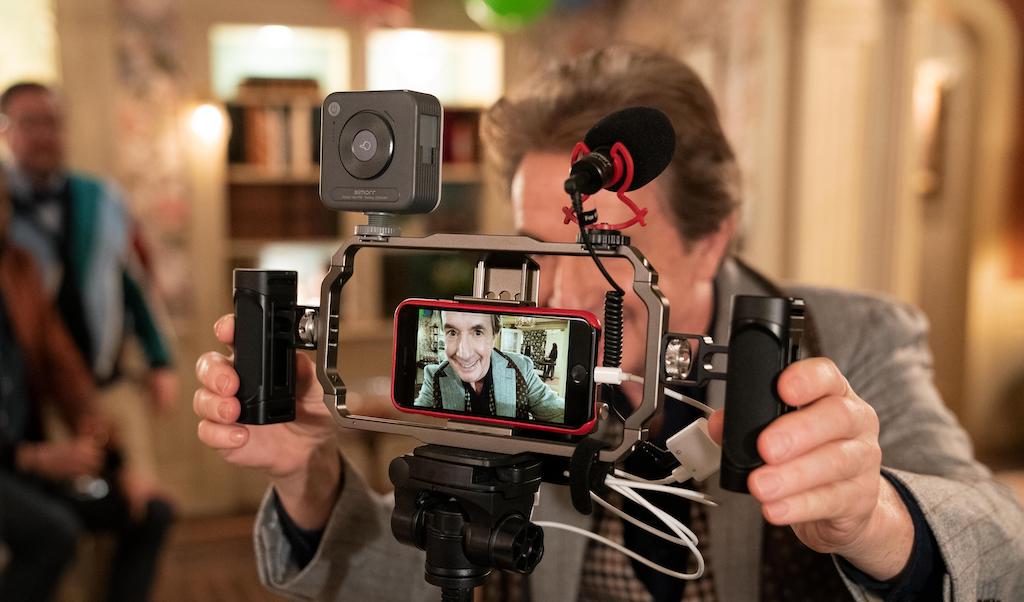
BTL: How come you didn’t shoot season three?
Teague: I got a pretty amazing opportunity to go to London and shoot a new Star Wars show with (director) Leslye Headland, who I had worked with on Russian Doll. I was very excited for the opportunity, but it was very hard not to go back to season three. I did end up showing up on the final day of production (season three) and got to say hello to everybody and hear that things went incredibly well. I think the only silver lining for me is that I get to watch season three as a fan just like everybody else.
BTL: Kyle Wullschleger who was actually your A Camera stepped in as cinematographer. Did he pick your brain?
Teague: Kyle and I talked a lot. We talked before the season started. I checked in with him regularly as the season went on. It was a very easy transition. Kyle knew the show well. He’s a quick learner and great with people, and he knew the crew very well. It felt like he was picking up where I left off.
BTL: Before I let you go, congratulations on your Emmy-nominatation for the finale episode “I Know You Did It.”
Teague: It was very surprising and exciting to be nominated. (Fellow nominees) Christian Sprenger is a friend, and Carl Herse is someone I’ve been recently introduced to, so I would love to get a chance to see them both in-person and congratulate them. What was fun about shooting the finale was that we really shot the final sequence of the season on the last day of production, so it was just a very intense but fun atmosphere. We had Paul Rudd on set for the first time, and we’re all massive fans of his. We got to work in this beautiful theater and create our kind of noir look for this new space in this mysterious theatrical production.
Honestly, we all knew only bits and pieces about what was going to go into the next season of the show and how we were going to seed things, but we sort of pulled back and did not give away too much to the audience. It was fun to kind of create this intentionally ambiguous, mysterious environment that was full of these very cool blue tones in the stage production (of Oliver’s Broadway return), which felt like a great departure from a lot of the show. It does, as you said, have a lot of warmth in it, a lot of warm tones, so it was a great moment to do a hard pivot in that direction.
BTL: Any idea why they chose that particular episode to nominate you out of an entire season?
Teague: It encapsulates a lot of what the show is about with this phenomenal ensemble. It’s such a wild series of moments, surprises, and turns, which was such a blast to shoot. I think that’s part of it. It shows off what’s so great about the show. I think that final episode and then this fun leap forward give you an inkling as to what next year’s mystery is going to be.
BTL: When you look back on your work for Only Murders In The Building, what are you most proud of?
Teague: I’m most proud of the fact that I’ve gotten to work with some legendary and just exceptional talents on the show. I feel the work that I did was able to contribute to the show in a meaningful way. There’s certainly a version of Only Murders that could have been more of a straight-down-the-middle comedy, but I think between all the work of camera, lighting, production design, costumes, and makeup, the show is elevated, and I think it really adds something to the show. I think it makes it feel more real, lush, and alive. I love that about it.
The Emmy-nominated Only Murders in the Building is now available to stream on Hulu.





